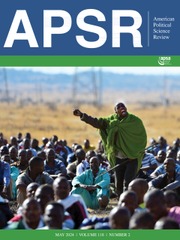Article contents
Explaining Presidential Priorities: The Competing Aspiration Levels Model of Macrobudgetary Decision Making
Published online by Cambridge University Press: 01 August 2014
Abstract
This article develops a new statistical model of trade-offs among defense, nondefense, and fiscal policy concerns as they are reflected in the presidential budgetary process. The Competing Aspiration Levels Model (CALM) builds on Crecine's (1971) “Great Identity” argument. Unlike most previous attempts to model presidential budgeting, CALM explicitly represents the interdependence of decisions about defense, nondefense, and total federal expenditures. CALM models this interdependence as the result of the interaction of minimal aspirations for defense and nondefense expenditures with a maximum acceptable level of expenditures from a fiscal policy standpoint. Statistical analyses of presidential budgets for the fiscal years from 1955 through 1980 provide strong support for the CALM formulation. Substantively, the results indicate that fiscal constraints on total expenditures have progressively weakened, that the maximum acceptable expenditure level has generally exceeded the minimal expenditure aspiration level, and that when a potential “fiscal surplus” has existed, the nondefense sector has been more successful in capturing a share of this surplus than the defense sector. In keeping with traditional incrementalist arguments, the results indicate that previous year expenditure levels provide a relatively secure “budgetary base” for both the defense and nondefense sectors. Both sectors tend to receive their minimal aspiration levels plus a share of whatever fiscal surplus exists. The analysis also indicates that the executive branch has not been as strong a direct force for budgetary growth as Congress.
Information
- Type
- Research Article
- Information
- Copyright
- Copyright © American Political Science Association 1984
References
- 37
- Cited by


Comments
No Comments have been published for this article.